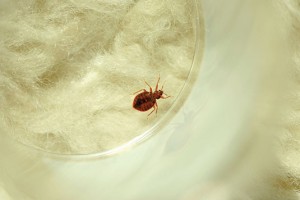
While heat can be an effective form of treatment, bed bugs can be wily when planning their escape. Photo: ©istock.com/dblight
Q. What are the pros and cons of heat treatments for bed bug control? I have had great success with thorough residual applications. A university I service asked about heat for dorm rooms. What do you think? JOHN B., ARIZONA
A. Heat can be a useful tool, especially if the infested contents can be enclosed to prevent bug escape. However, when treating rooms, the bugs will move into cracks and crevices to avoid heat. An application of a residual first helps prevent this migration. But that means you’re back to using insecticides. Heat treatments leave no residual to prevent reinfestation.
For dorm rooms, the traditional pesticide treatment is the most cost-effective option. Heat is ideal for treating bedding, books and other such items if they can be placed in a “tent” before heating.
Q. Mice are storing pet food in a residential customer’s wall. Now grain beetles are emerging from the wall. Short of opening up the wall, which the customer doesn’t want me to do, is there anything I can do to resolve the problem? BILL K., NEW HAMPSHIRE
A. You could blow a residual dust into the void(s) and an insect growth regulator (IGR) to stop reproduction. If the customer permits you to make a large enough opening, you could insert a dichlorvos (DDVP) strip. However, I wouldn’t guarantee this would work. Remind the customer the ultimate solution is to open the wall and remove the food. Shortcuts often don’t work.
Q. I’ve had a house under a termite contract for several years. This spring, I found old damage associated with a basement stairwell. There are several two-by-sixes, which penetrate the concrete slab, supporting the stairwell. The stairs are not against an outer wall. How did the termites get there, and how should I treat this problem? FRANK H., OHIO
A. I suspect the termites came up the two-by-sixes. The surest way to stop the problem is to cut off the two-by-sixes, dig out the old wood and fill the holes with cement. Other options include drilling through the slab next to each two-by-six and pumping termiticide beneath the slab or drill the two-by-sixes and inject a borate into them. But remember, a borate will continue to move downward into the soil, and you’ll lose protection eventually.
Q. A private school for children between ages 4 and 12 developed a rat infestation because of on-site bird feeders. The rats feed on the spillage. The school removed the feeders and cleaned up the spillage, but numerous rat burrows and rats are still present. I don’t want to put out bait stations, so what are my options? The school can keep the kids out of this area for a week if necessary. FRANK I., MASSACHUSETTS
A. If the kids can be kept out of the area, why not use bait stations? If you think the stations are still a problem, consider tracking powder in the burrows. If you do that, I would go back before the kids are permitted to enter the area, to make sure burrows are closed and no tracking powder is on an exposed surface.
Email your questions about insect identification and pest management technologies and techniques to Dr. Doug Mampe, an industry consultant, at dentomol@aol.com. Your questions most likely will be printed and answered in one of Pest Management Professional’s upcoming Ask the Expert columns.
Leave A Comment